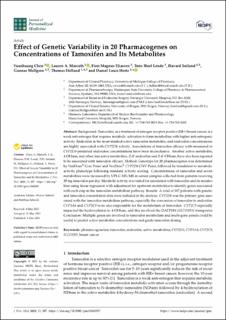Effect of genetic variability in 20 pharmacogenes on concentrations of tamoxifen and its metabolites
Chen, Yuanhuang; Marcath, Lauren A.; Eliassen, Finn Magnus; Lende, Tone Hoel; Soiland, Havard; Mellgren, Gunnar; Helland, Thomas; Hertz, Daniel Louis
Journal article, Peer reviewed
Published version

Åpne
Permanent lenke
https://hdl.handle.net/11250/2991063Utgivelsesdato
2021Metadata
Vis full innførselSamlinger
- Department of Clinical Science [2317]
- Registrations from Cristin [9766]
Sammendrag
Background: Tamoxifen, as a treatment of estrogen receptor positive (ER+) breast cancer, is a weak anti-estrogen that requires metabolic activation to form metabolites with higher anti-estrogenic activity. Endoxifen is the most-studied active tamoxifen metabolite, and endoxifen concentrations are highly associated with CYP2D6 activity. Associations of tamoxifen efficacy with measured or CYP2D6-predicted endoxifen concentrations have been inconclusive. Another active metabolite, 4-OHtam, and other, less active metabolites, Z-4′-endoxifen and Z-4′-OHtam, have also been reported to be associated with tamoxifen efficacy. Method: Genotype for 20 pharmacogenes was determined by VeriDose® Core Panel and VeriDose®CYP2D6 CNV Panel, followed by translation to metabolic activity phenotype following standard activity scoring. Concentrations of tamoxifen and seven metabolites were measured by UPLC-MS/MS in serum samples collected from patients receiving 20 mg tamoxifen per day. Metabolic activity was tested for association with tamoxifen and its metabolites using linear regression with adjustment for upstream metabolites to identify genes associated with each step in the tamoxifen metabolism pathway. Results: A total of 187 patients with genetic and tamoxifen concentration data were included in the analysis. CYP2D6 was the primary gene associated with the tamoxifen metabolism pathway, especially the conversion of tamoxifen to endoxifen. CYP3A4 and CYP2C9 were also responsible for the metabolism of tamoxifen. CYP2C9 especially impacted the hydroxylation to 4-OHtam, and this involved the OATP1B1 (SLCO1B1) transporter. Conclusion: Multiple genes are involved in tamoxifen metabolism and multi-gene panels could be useful to predict active metabolite concentrations and guide tamoxifen dosing.
